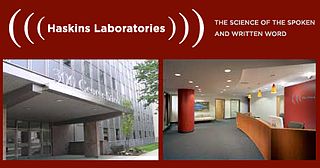Related Research Articles

Perception is the organization, identification, and interpretation of sensory information in order to represent and understand the presented information or environment. All perception involves signals that go through the nervous system, which in turn result from physical or chemical stimulation of the sensory system. Vision involves light striking the retina of the eye; smell is mediated by odor molecules; and hearing involves pressure waves.

Gestalt psychology, gestaltism, or configurationism is a school of psychology that emerged in the early twentieth century in Austria and Germany as a theory of perception that was a rejection of basic principles of Wilhelm Wundt's and Edward Titchener's elementalist and structuralist psychology.

Figure–ground organization is a type of perceptual grouping that is a vital necessity for recognizing objects through vision. In Gestalt psychology it is known as identifying a figure from the background. For example, black words on a printed paper are seen as the "figure", and the white sheet as the "background".
Speech perception is the process by which the sounds of language are heard, interpreted, and understood. The study of speech perception is closely linked to the fields of phonology and phonetics in linguistics and cognitive psychology and perception in psychology. Research in speech perception seeks to understand how human listeners recognize speech sounds and use this information to understand spoken language. Speech perception research has applications in building computer systems that can recognize speech, in improving speech recognition for hearing- and language-impaired listeners, and in foreign-language teaching.

Haskins Laboratories, Inc. is an independent 501(c) non-profit corporation, founded in 1935 and located in New Haven, Connecticut, since 1970. Haskins has formal affiliation agreements with both Yale University and the University of Connecticut; it remains fully independent, administratively and financially, of both Yale and UConn. Haskins is a multidisciplinary and international community of researchers that conducts basic research on spoken and written language. A guiding perspective of their research is to view speech and language as emerging from biological processes, including those of adaptation, response to stimuli, and conspecific interaction. Haskins Laboratories has a long history of technological and theoretical innovation, from creating systems of rules for speech synthesis and development of an early working prototype of a reading machine for the blind to developing the landmark concept of phonemic awareness as the critical preparation for learning to read an alphabetic writing system.
Embodied cognitive science is an interdisciplinary field of research, the aim of which is to explain the mechanisms underlying intelligent behavior. It comprises three main methodologies: the modeling of psychological and biological systems in a holistic manner that considers the mind and body as a single entity; the formation of a common set of general principles of intelligent behavior; and the experimental use of robotic agents in controlled environments.

Philip E. Rubin is an American cognitive scientist, technologist, and science administrator known for raising the visibility of behavioral and cognitive science, neuroscience, and ethical issues related to science, technology, and medicine, at a national level. His research career is noted for his theoretical contributions and pioneering technological developments, starting in the 1970s, related to speech synthesis and speech production, including articulatory synthesis and sinewave synthesis, and their use in studying complex temporal events, particularly understanding the biological bases of speech and language.
Carol Ann Fowler is an American experimental psychologist. She was president and director of research at Haskins Laboratories in New Haven, Connecticut from 1992 to 2008. She is also a professor of psychology at the University of Connecticut and adjunct professor of linguistics and psychology at Yale University. She received her undergraduate degree from Brown University in 1971, her M.A University of Connecticut in 1973 and her Ph.D. in psychology from the University of Connecticut in 1977.
Sinewave synthesis, or sine wave speech, is a technique for synthesizing speech by replacing the formants with pure tone whistles. The first sinewave synthesis program (SWS) for the automatic creation of stimuli for perceptual experiments was developed by Philip Rubin at Haskins Laboratories in the 1970s. This program was subsequently used by Robert Remez, Philip Rubin, David Pisoni, and other colleagues to show that listeners can perceive continuous speech without traditional speech cues, i.e., pitch, stress, and intonation. This work paved the way for a view of speech as a dynamic pattern of trajectories through articulatory-acoustic space.
Articulatory phonology is a linguistic theory originally proposed in 1986 by Catherine Browman of Haskins Laboratories and Louis Goldstein of University of Southern California and Haskins. The theory identifies theoretical discrepancies between phonetics and phonology and aims to unify the two by treating them as low- and high-dimensional descriptions of a single system.
Michael T. Turvey is the Board of Trustees' Distinguished Professor of Experimental Psychology at the University of Connecticut and a Senior Scientist at Haskins Laboratories in New Haven, Connecticut. He is best known for his pioneering work in ecological psychology and in applying dynamic systems approach for the study of motor behavior. He is the founder of the Center for the Ecological Study of Perception and Action. His research spans a number of areas including: dynamic touch and haptics, interlimb coordination, visual perception and optic flow, postural stability, visual word recognition and speech perception. Along with William Mace and Robert Shaw, he has been one of the leading explicators of the ecological psychology of J. J. Gibson. His pioneering work with J. A. Scott Kelso and Peter N. Kugler introduced the physical language of complex systems to the understanding of perception and action. He also helped to introduce the ideas of Russian motor control theorist, Nikolai Bernstein, and his colleagues to a larger audience. Working with Georgije Lukatela and other colleagues at Haskins Laboratories, he has exploited the dual nature of the Serbo-Croatian orthography to help understand word recognition.
Self-categorization theory is a theory in social psychology that describes the circumstances under which a person will perceive collections of people as a group, as well as the consequences of perceiving people in group terms. Although the theory is often introduced as an explanation of psychological group formation, it is more accurately thought of as general analysis of the functioning of categorization processes in social perception and interaction that speaks to issues of individual identity as much as group phenomena. It was developed by John Turner and colleagues, and along with social identity theory it is a constituent part of the social identity approach. It was in part developed to address questions that arose in response to social identity theory about the mechanistic underpinnings of social identification.
Dominic W. Massaro is Professor of Psychology and Computer Engineering at the University of California, Santa Cruz. He is best known for his fuzzy logical model of perception, and more recently, for his development of the computer animated talking head Baldi. Massaro is director of the Perceptual Science Laboratory, past president of the Society for Computers in Psychology, book review editor for the American Journal of Psychology, founding Chair of UCSC's Digital Arts and New Media program, and was founding co-editor of the interdisciplinary journal Interpreting. He has been a Guggenheim Fellow, a University of Wisconsin Romnes Fellow, a James McKeen Cattell Fellow, an NIMH Fellow, and in 2006 was recognized as a Tech Museum Award Laureate.
Common coding theory is a cognitive psychology theory describing how perceptual representations and motor representations are linked. The theory claims that there is a shared representation for both perception and action. More important, seeing an event activates the action associated with that event, and performing an action activates the associated perceptual event.

Albert Stanley "Al" Bregman is a Canadian professor and researcher in experimental psychology, cognitive science, and Gestalt psychology, primarily in the perceptual organization of sound.
The processing fluency theory of aesthetic pleasure is a theory in psychological aesthetics on how people experience beauty. Processing fluency is the ease with which information is processed in the human mind.

Embodied cognition is the theory that many features of cognition, whether human or otherwise, are shaped by aspects of an organism's entire body. Sensory and motor systems are seen as fundamentally integrated with cognitive processing. The cognitive features include high-level mental constructs and performance on various cognitive tasks. The bodily aspects involve the motor system, the perceptual system, the bodily interactions with the environment (situatedness), and the assumptions about the world built into the organism's functional structure.
Philip Kellman is Distinguished Professor of Psychology and the current Cognitive Area Chair in the Department of Psychology at the University of California, Los Angeles. He is also Adjunct Professor of Surgery in the David Geffen UCLA School of Medicine, and the founder of Insight Learning Technology, Inc, a company that applies perceptual learning, adaptive learning technology, and principles from cognitive science research to improve education and training. His research interests involve perception and visual cognition, specifically visual perception of objects, shape, space, and motion, and perceptual development. He is also an expert in perceptual learning, adaptive learning, and their applications to skill acquisition and educational technology.
Lola L. Cuddy is a Canadian psychologist recognized for her contributions to the field of music psychology. She is a professor emerita in the Department of Psychology at Queen's University in Kingston, Ontario.

Michael Kubovy is an Israeli American psychologist known for his work on the psychology of perception and psychology of art.
References
- 1 2 3 4 5 6 7 "Robert E. Remez Biographical Sketch". Columbia University. Archived from the original on July 9, 2018. Retrieved July 9, 2018.
- ↑ "Language & Cognition". Columbia University. Archived from the original on July 9, 2018. Retrieved July 9, 2018.
- ↑ "2. Perceptual Organization of Speech". Blackwell Reference Online. Archived from the original on July 9, 2018. Retrieved July 9, 2018.
- ↑ "Multimodal perceptual organization of speech: Evidence from tone analogs of spoken utterances". Science Direct . Archived from the original on 2013-02-01. Retrieved July 8, 2018.
- ↑ Remez, Robert E.; Pisoni, David B. (2004). The Handbook of Speech Perception. Blackwell Publishing. ISBN 9780631229278.
- ↑ "Implications for Speech Production of a General Theory of Action" (PDF). Yale University . Retrieved July 9, 2018.
- ↑ "Implications for Speech Production of a General Theory of Action". Yale University. Retrieved July 9, 2018.
- ↑ "On the Perceptual Organization of Speech" (PDF). Yale University. Retrieved July 9, 2018.
- ↑ "The Handbook of Speech Perception". Blackwell Publishing. Archived from the original on July 9, 2018. Retrieved July 9, 2018.